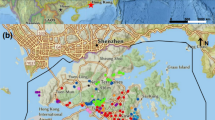Abstract
The issue of classifying rock images is one of most important problems in geological detection and analysis. In order to improve rock recognition performance, we use convolution neural network (CNN) based deep learning method to classify ihomogeneous rock images intelligently. We present the depthwise separable convolution method for rock image classification, which reduces the required parameters compared to normal convolution, and achieves the separation of channels and regions. In our experiments, there are 12 kinds of common rock image data collected by us. Generally, similar rocks such as limestone and dolomite are easy to be confused, which is the same as that of rock with naked eyes. Compared with the model Inception, the rock image classification accuracy can be improved 9% by using the depth separable convolution model Xception. Meanwhile, after analyzing feature maps of granite and slate generated by the proposed model, we can easily find that the color, mineral composition and structure of the rock image are extracted successfully.
Access this chapter
Tax calculation will be finalised at checkout
Purchases are for personal use only
Similar content being viewed by others
References
Chatterjee, S.: Vision-based rock-type classification of limestone using multi-class support vector machine. Appl. Intell. 39(1), 14–27 (2013)
Patel, A.K., Chatterjee, S.: Computer vision-based limestone rock-type classification using probabilistic neural network. Geosci. Front. 7(1), 53–60 (2016)
Lepistö, L., Kunttu, I., Visa, A.: Color-based classification of natural rock images using classifier combinations. In: Kalviainen, H., Parkkinen, J., Kaarna, A. (eds.) SCIA 2005. LNCS, vol. 3540, pp. 901–909. Springer, Heidelberg (2005). https://doi.org/10.1007/11499145_91
Lepistö, L., Kunttu, I., Visa, A.: Rock image classification using color features in Gabor space. J. Electron. Imaging 14(4), 040503 (2005)
Singh, N., Singh, T.N., Tiwary, A.: Textural identification of basaltic rock mass using image processing and neural network. Comput. Geosci. 14(2), 301–310 (2010)
Fukushima, K.: Neocognitron: a self-organizing neural network model for a mechanism of pattern recognition unaffected by shift in position. Biol. Cybern. 36(4), 193–202 (1980)
Lepistö, L., Kunttu, I., Visa, A.: Rock image classification based on k-nearest neighbour voting. IEE Proc. Vis. Image Signal Process 153(4), 475–482 (2006)
Shang, C., Barnes, D.: Support vector machine-based classification of rock texture images aided by efficient feature selection. In: Proceedings of the International Joint Conference on Neural Network, pp. 1–8 (2012)
Sharif, H., Ralchenko, M., Samson, C.: Autonomous rock classification using Bayesian image analysis for rover-based planetary exploration. Comput. Geosci. 83, 153–167 (2015)
Perez, C.A., Saravia, J.A., Navarro, C.F.: Rock lithological classification using multi-scale Gabor features from sub-images, and voting with rock contour information. Int. J. Miner. Process. 144, 56–64 (2015)
Shu, L., McIsaac, K., Osinski, G.: Unsupervised feature learning for autonomous rock image classification. Comput. Geosci. 106, 10–17 (2017)
Zhang, Y., Li, M.C.: Automatic identification and classification in lithology based on deep learning in rock images. Acta Petrol. Sin. 34(2), 333–342 (2018)
Bai, L., Yao, Y.: Mineral composition analysis of rock image based on deep learning feature extraction. China Min. Mag. 27(07), 178–182 (2018)
Hubel, D.H., Wiesel, T.N.: Receptive fields binocular interaction and functional architecture in the cat’s visual cortex. J. Physiol. 160(1), 106–154 (1962)
LeCun, Y., Bottou, L., Bengio, Y.: Gradient-based learning applied to document recognition. Proc. IEEE 86(11), 2278–2324 (1998)
Litjens, G., Kooi, T., Bejnordi, B.E.: A survey on deep learning in medical image analysis. Med. Image Anal. 42, 60–88 (2017)
LeCun, Y., Bengio, Y., Hinton, G.: Deep learning. Nature 521(7553), 436 (2015)
Chollet, F.: Xception: deep learning with depthwise separable convolutions. In: Proceedings of the IEEE Computer Society Conference on Computer Vision and Pattern Recognition 1800–1807 (2017)
Luo, X., Sun, J., Wang, L.: Short-term wind speed forecasting via stacked extreme learning machine with generalized correntropy. IEEE Trans. Ind. Inf. (2018) https://doi.org/10.1109/tii.2018.2854549
Luo, X., Xu, Y., Wang, W.: Towards enhancing stacked extreme learning machine with sparse autoencoder by correntropy. J. Franklin Inst. 355(4), 1945–1966 (2018)
Acknowledgment
This work is supported by the National Key R&D Program of China under Grant 2016YFC0600510, and National undergraduate innovation and entrepreneurship training program of Chengdu University of Technology, and the Key Laboratory of Geological Information Technology of Ministry of Land and Resources under Grant.
Author information
Authors and Affiliations
Corresponding author
Editor information
Editors and Affiliations
Rights and permissions
Copyright information
© 2019 Springer Nature Singapore Pte Ltd.
About this paper
Cite this paper
Zhu, Y., Bai, L., Peng, W., Zhang, X., Luo, X. (2019). Depthwise Separable Convolution Feature Learning for Ihomogeneous Rock Image Classification. In: Sun, F., Liu, H., Hu, D. (eds) Cognitive Systems and Signal Processing. ICCSIP 2018. Communications in Computer and Information Science, vol 1005. Springer, Singapore. https://doi.org/10.1007/978-981-13-7983-3_15
Download citation
DOI: https://doi.org/10.1007/978-981-13-7983-3_15
Published:
Publisher Name: Springer, Singapore
Print ISBN: 978-981-13-7982-6
Online ISBN: 978-981-13-7983-3
eBook Packages: Computer ScienceComputer Science (R0)




